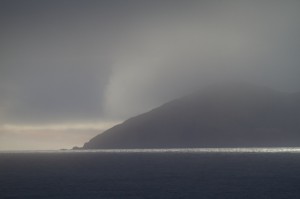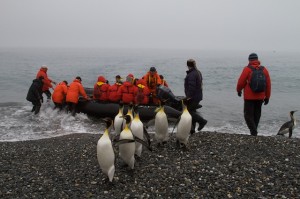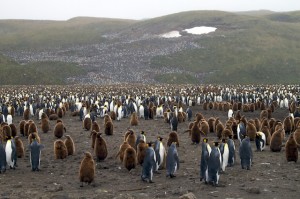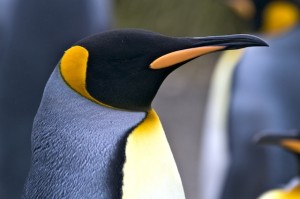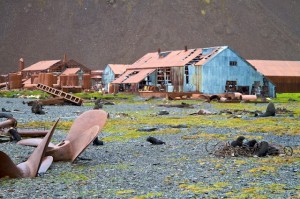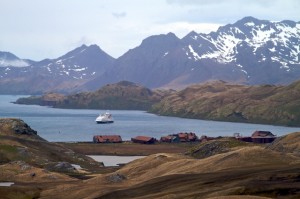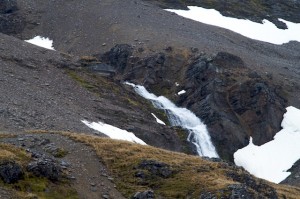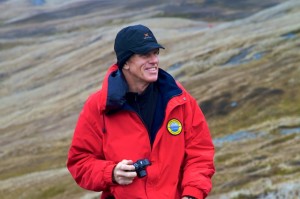Despite the terrible reputation of the stretch between the Falklands and South Georgia, our passage was easy – smooth seas and light winds.
Dawn found us anchored off the shore of Salisbury Plain, one of the best king penguin rookeries anywhere. Read more…
Mist and clouds surrounded the tall craggy mountains above the beach at Salisbury. Along the distant strip of beach you could just make out the harems of fur seals. But what was above the beach drew most of the attention. Large patches or fingers could be seen extending up the green lower slopes of the foothills. Once we landed on the beach it became clear these were staggeringly huge colonies of king penguins, the second largest of the penguins.
A few clutches of kings wandered about on the beach, some just having tumbled in from the waves hitting the shore. But as we moved inland, past the aggressive and quarrelsome fur seals defending their harems, the colony grew and grew until it was solid penguin, beak to beak, flipper to flipper. Most were adults with their beautiful orange throats, but there were many ‘bearcoats’, young chicks still wearing the brown, fluffy down they would soon shed.
South Georgia’s place in history is pivotal in the southern seas. Claimed by the British in the 18th Century, it served as a whaling and sealing center right up until the 1960s. In fact the whaling station at Grytviken was one of the most productive in the world. The island provided a jumping off point for many well-known Antarctic exploration parties, one of the most famous being the ill-fated Shackleton expedition.
In what has become one of history’s most amazing tales of heroism and survival, the Shackleton Expedition continues to astound and inspire. Ernest Shackleton and a small band of explorers set sail on December 5, 1914 aboard the Endurance, an ice-strengthened wooden hull, three-masted sailing ship for the Weddell Sea, hoping to beat explorer Roald Amundsen to the South Pole.
Within a short distance of the continent, the Endurance was stuck in sea ice and Shackleton and his men were stranded on the ice as the ship was crushed and sank. Dragging supplies and their lifeboats across the ice northward, they then rowed hundreds of miles to Elephant Island, landing on a rocky finger of land. Shackleton left most of the crew at Elephant Island and took four men, re-boarded one of the boats, and rowed and partially sailed another 800 miles back to South Georgia Island.
Their ordeal was hardly over, however. In order to get help at one of the whaling stations they had to cross a mountain range with peaks up to 7,000 feet. So Shackleton left two men with the boat and provisions, and set out with two others on a harrowing three day journey, eventually arriving at the whaling station of Stromness.
In a final unbelievable act of heroism, they obtained a Chilean vessel and returned to Elephant Island and rescued the stranded explorers. It had been a year and a half since they left South Georgia on the Endurance and not a man was lost.
Shackleton returned to South Georgia several years later (h
e was knighted by the Queen of England) for another attempt on the pole, but suffered a heart attack at the age of just 45. Sir Ernest Shackleton was buried in the little whalers’ cemetery at Grytviken, per his wife’s wishes, with his grave pointed south to Antarctica. All of the others’ graves point east.
If you’d like to read more about this incredible journey, pick up a copy of Endurance at your library or bookstore.
In the afternoon, our own landing at Stromness was less about survival and more about discovery. The little whaling station is of course long abandoned and falling apart. We weren’t able to poke around the ruins, as the high winds made the danger of blowing sheet metal dangerous and the facility is full of asbestos, posing another risk of a different kind. Instead we photographed the many fur and elephant seals on the beach, as well as a number of gentoo penguins.
One of our expedition staff is Sir Peter Hillary, son of Sir Edmund Hillary, one of the first two men to climb Mount Everest. Peter has climbed Everest twice himself as well as leading the first expedition to the South Pole on skis. Peter took a small group of us a couple of miles up a beautiful braided river valley to the waterfall that Shackleton and his men were forced to descend in their wintertime trek across the mountains.
Next: Grytviken
